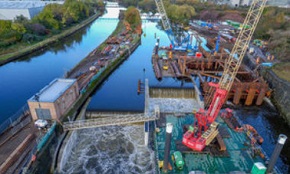Leeds flood defences
In October 2017, a £50 million flood alleviation scheme opened in Leeds which uses moveable weir technology – a first for flood risk reduction in the UK.
The first phase of the award-winning Leeds Flood Alleviation Scheme not only uses state-of-the-art flood defence engineering techniques but is one of the largest river flood alleviation schemes in the country.
Led by Leeds City Council in partnership with the Environment Agency, the scheme will provide more than 3,000 homes, 500 businesses and 300 acres of development land with increased protection against flooding from the River Aire and Hol Beck.
According to government figures, more than 22,000 jobs will be safeguarded over the next 10 years due to the increased level of protection and through the scheme’s development and construction, 150 jobs and apprenticeships have been created.
It comprises three main elements: state-of-the-art mechanical weirs, the merging of the river and canal and flood walls and embankments stretching 4.5 km through the city centre.
The scheme, which sees work on the River Aire now substantially complete and work at Holbeck continuing into autumn, was officially opened by the Leader of the Council, Councillor Judith Blake CBE and Chair of the Environment Agency, Emma Howard Boyd.
Multiple funding streams have contributed towards the cost of this £50 million scheme, including £35m of government Grant in Aid funding alongside £10m of local funding from Leeds City Council and partnership funding from Leeds City Region Enterprise Partnership and others. The government is spending £2.5 billion to protect a further 300,000 homes by 2021.
Leader of Leeds City Council Judith Blake CBE said:
"We are delighted to see this much-needed first phase of the Leeds Flood Alleviation Scheme opened. As could be seen by the devastation at Christmas 2015, providing increased flood protection in Leeds is essential in terms of reassuring our residents and businesses, and this fantastic state-of-the-art scheme provides it for the city centre and downstream at Woodlesford.
"The clever use of the mechanical weirs is a brilliant idea, and they have also brought about environmental benefits with the improved river quality bringing salmon and otters, while the new bridge looks stunning offering great views of the river and beyond as part of the Trans Pennine Trail.
'We’d like to thank everyone involved in this phase of the scheme and look forward to developing the plans for phase two and beyond, as only through an entire catchment and citywide approach can we protect all communities in Leeds from the threat of flooding."
This article was originally published here by CIAT on 5 Oct 2017.
--CIAT
[edit] Related articles on Designing Buildings Wiki
Featured articles and news
Latest Build UK Building Safety Regime explainer published
Key elements in one short, now updated document.
UKGBC launch the UK Climate Resilience Roadmap
First guidance of its kind on direct climate impacts for the built environment and how it can adapt.
CLC Health, Safety and Wellbeing Strategy 2025
Launched by the Minister for Industry to look at fatalities on site, improving mental health and other issues.
One of the most impressive Victorian architects. Book review.
Common Assessment Standard now with building safety
New CAS update now includes mandatory building safety questions.
RTPI leader to become new CIOB Chief Executive Officer
Dr Victoria Hills MRTPI, FICE to take over after Caroline Gumble’s departure.
Social and affordable housing, a long term plan for delivery
The “Delivering a Decade of Renewal for Social and Affordable Housing” strategy sets out future path.
A change to adoptive architecture
Effects of global weather warming on architectural detailing, material choice and human interaction.
The proposed publicly owned and backed subsidiary of Homes England, to facilitate new homes.
How big is the problem and what can we do to mitigate the effects?
Overheating guidance and tools for building designers
A number of cool guides to help with the heat.
The UK's Modern Industrial Strategy: A 10 year plan
Previous consultation criticism, current key elements and general support with some persisting reservations.
Building Safety Regulator reforms
New roles, new staff and a new fast track service pave the way for a single construction regulator.
Architectural Technologist CPDs and Communications
CIAT CPD… and how you can do it!
Cooling centres and cool spaces
Managing extreme heat in cities by directing the public to places for heat stress relief and water sources.
Winter gardens: A brief history and warm variations
Extending the season with glass in different forms and terms.
Restoring Great Yarmouth's Winter Gardens
Transforming one of the least sustainable constructions imaginable.
























